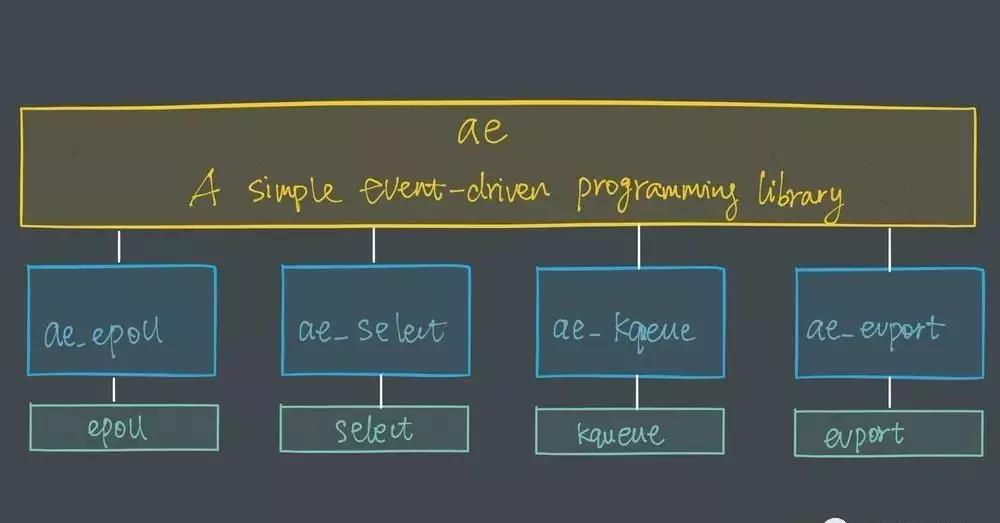几种 I/O 模型
- Blocking I/O
- I/O 多路复用
Reactor 设计模式
I/O 多路复用模块
- 封装 select 函数
- 封装 epoll 函数
- 子模块的选择
总结
Reference
最近在看 UNIX 网络编程并研究了一下 Redis 的实现,感觉 Redis 的源代码十分适合阅读和分析,其中 I/O 多路复用(mutiplexing)部分的实现非常干净和优雅,在这里想对这部分的内容进行简单的整理。
几种 I/O 模型
为什么 Redis 中要使用 I/O 多路复用这种技术呢?
首先,Redis 是跑在单线程中的,所有的操作都是按照顺序线性执行的,但是由于读写操作等待用户输入或输出都是阻塞的,所以 I/O 操作在一般情况下往往不能直接返回,这会导致某一文件的 I/O 阻塞导致整个进程无法对其它客户提供服务,而 I/O 多路复用就是为了解决这个问题而出现的。
Blocking I/O
先来看一下传统的阻塞 I/O 模型到底是如何工作的:当使用 read 或者 write 对某一个文件描述符(File Descriptor 以下简称 FD)进行读写时,如果当前 FD 不可读或不可写,整个 Redis 服务就不会对其它的操作作出响应,导致整个服务不可用。
这也就是传统意义上的,也就是我们在编程中使用最多的阻塞模型:
blocking-io
阻塞模型虽然开发中非常常见也非常易于理解,但是由于它会影响其他 FD 对应的服务,所以在需要处理多个客户端任务的时候,往往都不会使用阻塞模型。
I/O 多路复用
虽然还有很多其它的 I/O 模型,但是在这里都不会具体介绍。
阻塞式的 I/O 模型并不能满足这里的需求,我们需要一种效率更高的 I/O 模型来支撑 Redis 的多个客户(redis-cli),这里涉及的就是 I/O 多路复用模型了:
I:O-Multiplexing-Mode
在 I/O 多路复用模型中,最重要的函数调用就是 select,该方法的能够同时监控多个文件描述符的可读可写情况,当其中的某些文件描述符可读或者可写时,select 方法就会返回可读以及可写的文件描述符个数。
关于 select 的具体使用方法,在网络上资料很多,这里就不过多展开介绍了;
与此同时也有其它的 I/O 多路复用函数 epoll/kqueue/evport,它们相比 select 性能更优秀,同时也能支撑更多的服务。
Reactor 设计模式
Redis 服务采用 Reactor 的方式来实现文件事件处理器(每一个网络连接其实都对应一个文件描述符)
redis-reactor-pattern
文件事件处理器使用 I/O 多路复用模块同时监听多个 FD,当 accept、read、write 和 close 文件事件产生时,文件事件处理器就会回调 FD 绑定的事件处理器。
虽然整个文件事件处理器是在单线程上运行的,但是通过 I/O 多路复用模块的引入,实现了同时对多个 FD 读写的监控,提高了网络通信模型的性能,同时也可以保证整个 Redis 服务实现的简单。
I/O 多路复用模块
I/O 多路复用模块封装了底层的 select、epoll、avport 以及 kqueue 这些 I/O 多路复用函数,为上层提供了相同的接口。
ae-module
在这里我们简单介绍 Redis 是如何包装 select 和 epoll 的,简要了解该模块的功能,整个 I/O 多路复用模块抹平了不同平台上 I/O 多路复用函数的差异性,提供了相同的接口:
- static int aeApiCreate(aeEventLoop *eventLoop)
- static int aeApiResize(aeEventLoop *eventLoop, int setsize)
- static void aeApiFree(aeEventLoop *eventLoop)
- static int aeApiAddEvent(aeEventLoop *eventLoop, int fd, int mask)
- static void aeApiDelEvent(aeEventLoop *eventLoop, int fd, int mask)
- static int aeApiPoll(aeEventLoop *eventLoop, struct timeval *tvp)
同时,因为各个函数所需要的参数不同,我们在每一个子模块内部通过一个 aeApiState 来存储需要的上下文信息:
- // select
- typedef struct aeApiState {
- fd_set rfds, wfds;
- fd_set _rfds, _wfds;
- } aeApiState;
- // epoll
- typedef struct aeApiState {
- int epfd;
- struct epoll_event *events;
- } aeApiState;
这些上下文信息会存储在 eventLoop 的 void *state 中,不会暴露到上层,只在当前子模块中使用。
封装 select 函数
select 可以监控 FD 的可读、可写以及出现错误的情况。
在介绍 I/O 多路复用模块如何对 select 函数封装之前,先来看一下 select 函数使用的大致流程:
- int fd = /* file descriptor */
- fd_set rfds;
- FD_ZERO(&rfds);
- FD_SET(fd, &rfds)
- for ( ; ; ) {
- select(fd+1, &rfds, NULL, NULL, NULL);
- if (FD_ISSET(fd, &rfds)) {
- /* file descriptor `fd` becomes readable */
- }
- }
- 初始化一个可读的 fd_set 集合,保存需要监控可读性的 FD;
- 使用 FD_SET 将 fd 加入 rfds;
- 调用 select 方法监控 rfds 中的 FD 是否可读;
- 当 select 返回时,检查 FD 的状态并完成对应的操作。
而在 Redis 的 ae_select 文件中代码的组织顺序也是差不多的,首先在 aeApiCreate 函数中初始化 rfds 和 wfds:
- static int aeApiCreate(aeEventLoop *eventLoop) {
- aeApiState *state = zmalloc(sizeof(aeApiState));
- if (!state) return -1;
- FD_ZERO(&state->rfds);
- FD_ZERO(&state->wfds);
- eventLoop->apidata = state;
- return 0;
- }
而 aeApiAddEvent 和 aeApiDelEvent 会通过 FD_SET 和 FD_CLR 修改 fd_set 中对应 FD 的标志位:
整个 ae_select 子模块中最重要的函数就是 aeApiPoll,它是实际调用 select 函数的部分,其作用就是在 I/O 多路复用函数返回时,将对应的 FD 加入 aeEventLoop 的 fired 数组中,并返回事件的个数:
- static int aeApiPoll(aeEventLoop *eventLoop, struct timeval *tvp) {
- aeApiState *state = eventLoop->apidata;
- int retval, j, numevents = 0;
- memcpy(&state->_rfds,&state->rfds,sizeof(fd_set));
- memcpy(&state->_wfds,&state->wfds,sizeof(fd_set));
- retval = select(eventLoop->maxfd+1,
- &state->_rfds,&state->_wfds,NULL,tvp);
- if (retval > 0) {
- for (j = 0; j <= eventloop-="">maxfd; j++) {
- int mask = 0;
- aeFileEvent *fe = &eventLoop->events[j];
- if (fe->mask == AE_NONE) continue;
- if (fe->mask & AE_READABLE && FD_ISSET(j,&state->_rfds))
- mask |= AE_READABLE;
- if (fe->mask & AE_WRITABLE && FD_ISSET(j,&state->_wfds))
- mask |= AE_WRITABLE;
- eventLoop->fired[numevents].fd = j;
- eventLoop->fired[numevents].mask = mask;
- numevents++;
- }
- }
- return numevents;
- }
封装 epoll 函数
Redis 对 epoll 的封装其实也是类似的,使用 epoll_create 创建 epoll 中使用的 epfd:
- static int aeApiCreate(aeEventLoop *eventLoop) {
- aeApiState *state = zmalloc(sizeof(aeApiState));
- if (!state) return -1;
- state->events = zmalloc(sizeof(struct epoll_event)*eventLoop->setsize);
- if (!state->events) {
- zfree(state);
- return -1;
- }
- state->epfd = epoll_create(1024); /* 1024 is just a hint for the kernel */
- if (state->epfd == -1) {
- zfree(state->events);
- zfree(state);
- return -1;
- }
- eventLoop->apidata = state;
- return 0;
- }
在 aeApiAddEvent 中使用 epoll_ctl 向 epfd 中添加需要监控的 FD 以及监听的事件:
- static int aeApiAddEvent(aeEventLoop *eventLoop, int fd, int mask) {
- aeApiState *state = eventLoop->apidata;
- struct epoll_event ee = {0}; /* avoid valgrind warning */
- /* If the fd was already monitored for some event, we need a MOD
- * operation. Otherwise we need an ADD operation. */
- int op = eventLoop->events[fd].mask == AE_NONE ?
- EPOLL_CTL_ADD : EPOLL_CTL_MOD;
- ee.events = 0;
- mask |= eventLoop->events[fd].mask; /* Merge old events */
- if (mask & AE_READABLE) ee.events |= EPOLLIN;
- if (mask & AE_WRITABLE) ee.events |= EPOLLOUT;
- ee.data.fd = fd;
- if (epoll_ctl(state->epfd,op,fd,&ee) == -1) return -1;
- return 0;
- }
由于 epoll 相比 select 机制略有不同,在 epoll_wait 函数返回时并不需要遍历所有的 FD 查看读写情况;在 epoll_wait 函数返回时会提供一个 epoll_event 数组:
- typedef union epoll_data {
- void *ptr;
- int fd; /* 文件描述符 */
- uint32_t u32;
- uint64_t u64;
- } epoll_data_t;
- struct epoll_event {
- uint32_t events; /* Epoll 事件 */
- epoll_data_t data;
- };
其中保存了发生的 epoll 事件(EPOLLIN、EPOLLOUT、EPOLLERR 和 EPOLLHUP)以及发生该事件的 FD。
aeApiPoll 函数只需要将 epoll_event 数组中存储的信息加入 eventLoop 的 fired 数组中,将信息传递给上层模块:
- static int aeApiPoll(aeEventLoop *eventLoop, struct timeval *tvp) {
- aeApiState *state = eventLoop->apidata;
- int retval, numevents = 0;
- retval = epoll_wait(state->epfd,state->events,eventLoop->setsize,
- tvp ? (tvp->tv_sec*1000 + tvp->tv_usec/1000) : -1);
- if (retval > 0) {
- int j;
- numevents = retval;
- for (j = 0; j < numevents; j++) {
- int mask = 0;
- struct epoll_event *e = state->events+j;
- if (e->events & EPOLLIN) mask |= AE_READABLE;
- if (e->events & EPOLLOUT) mask |= AE_WRITABLE;
- if (e->events & EPOLLERR) mask |= AE_WRITABLE;
- if (e->events & EPOLLHUP) mask |= AE_WRITABLE;
- eventLoop->fired[j].fd = e->data.fd;
- eventLoop->fired[j].mask = mask;
- }
- }
- return numevents;
- }
子模块的选择
因为 Redis 需要在多个平台上运行,同时为了最大化执行的效率与性能,所以会根据编译平台的不同选择不同的 I/O 多路复用函数作为子模块,提供给上层统一的接口;在 Redis 中,我们通过宏定义的使用,合理的选择不同的子模块:
- #ifdef HAVE_EVPORT
- #include "ae_evport.c"
- #else
- #ifdef HAVE_EPOLL
- #include "ae_epoll.c"
- #else
- #ifdef HAVE_KQUEUE
- #include "ae_kqueue.c"
- #else
- #include "ae_select.c"
- #endif
- #endif
- #endif
因为 select 函数是作为 POSIX 标准中的系统调用,在不同版本的操作系统上都会实现,所以将其作为保底方案:
redis-choose-io-function
Redis 会优先选择时间复杂度为
的 I/O 多路复用函数作为底层实现,包括 Solaries 10 中的 evport、Linux 中的 epoll 和 macOS/FreeBSD 中的 kqueue,上述的这些函数都使用了内核内部的结构,并且能够服务几十万的文件描述符。
但是如果当前编译环境没有上述函数,就会选择 select 作为备选方案,由于其在使用时会扫描全部监听的描述符,所以其时间复杂度较差,并且只能同时服务 1024 个文件描述符,所以一般并不会以 select 作为第一方案使用。
总结
Redis 对于 I/O 多路复用模块的设计非常简洁,通过宏保证了 I/O 多路复用模块在不同平台上都有着优异的性能,将不同的 I/O 多路复用函数封装成相同的 API 提供给上层使用。
整个模块使 Redis 能以单进程运行的同时服务成千上万个文件描述符,避免了由于多进程应用的引入导致代码实现复杂度的提升,减少了出错的可能性。
Reference
- Select-Man-Pages
- Reactor-Pattern
- epoll vs kqueue









































